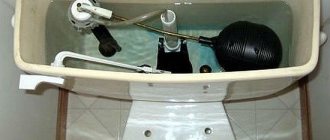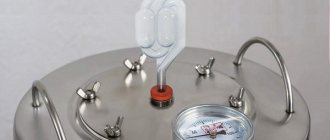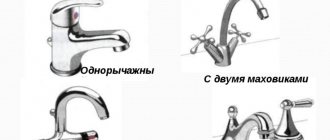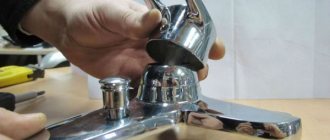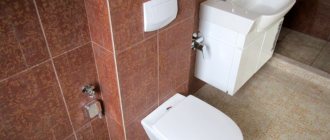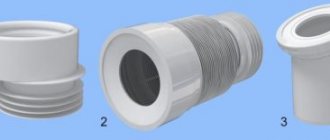Modern toilets are comfortable and aesthetically pleasing, and the inside smells pleasantly of scented products. To make it comfortable to be in the bathroom, it requires special care. Do you agree? The room must be constantly cleaned and problems, including the formation of condensation, must be eliminated in a timely manner.
If water constantly flows down the outer surface of the tank, an unpleasant odor appears in the apartment over time, and the plumbing fixture loses its attractive appearance. To get rid of condensation and avoid negative consequences, you need to find out why the toilet tank in the bathroom is sweating.
We will tell you how to independently figure out and eliminate the cause of tank leakage. Useful recommendations and expert advice are presented in our material. For clarity, it is accompanied by thematic photographs and videos. This will help you get to the root of the problem faster.
Causes of condensation
If drops of water are constantly forming on the tank of your toilet, the first thing you need to do is identify the cause of their appearance.
A common cause of condensation in the toilet is high humidity in the room. To normalize this indicator, it is necessary to identify the cause of the increase in humidity.
Dry indoor air has a negative effect on human health, but high humidity also leads to bad consequences. This may cause fogging of the tank, walls and floor.
Increased humidity in the bathroom can be caused by various reasons:
- The apartment or house contains a large aquarium or a lot of vegetation that requires constant watering. In these cases, the problem can be solved by installing dehumidifiers.
- Washing and drying clothes is carried out in significant volumes, which is more often observed in large families. It is recommended to hang washed laundry on the balcony or in the yard.
- Moisture can settle on the cistern and bathroom wall surfaces due to leaking sewer pipes or connections. It is urgent to identify and fix the plumbing problem.
- Insufficient ventilation does not fulfill its functions, as a result of which the room cannot dry quickly.
- Due to a breakdown of the shut-off valves, cold water may constantly flow in the tank, which does not have time to reach room temperature and causes condensation to appear on the walls of the plumbing.
Condensation forms on the tank of plumbing equipment due to the fact that the air temperature in the room differs from the temperature of the water in the toilet by about 15 degrees. Therefore, the outer surface of the tank begins to fog up.
Since water enters the toilet from a water supply system located underground or outdoors, its temperature depends on external weather conditions.
In winter, the heating season begins, during which the room heats up. During this period, the greatest difference in temperature between the air in the bathroom and the water in the toilet is observed.
The laws of physics will help identify the original source of the malfunction. As you know, warm air currents, in contact with cold water (in the drain tank), are converted into droplets of moisture. The process of condensation formation on the tank can be stopped by studying in more detail the possible causes of this phenomenon and ways to eliminate them.
Negative consequences
The owner of an apartment or private house has the right to independently decide when to begin solving the problem with condensation. In most cases, the tank does not sweat constantly; drops of water have time to dry. This does not create problems or negative consequences, but if the tank is constantly sweating, then drops of water will flow down the surface of the device and fall on the floor. Small puddles will appear that will have to be constantly cleaned up, which creates certain inconvenience even for the owner of the dacha.
The main consequences of moisture condensation on the tank:
- drops of liquid fall into the cracks of the floor covering. It is virtually impossible to remove water from there. After some time, mold forms on problem areas, a specific smell appears,
- the air humidity in the room increases, which leads to intensive development of pathogenic bacteria, the appearance of fungus and mold on the walls of the room and plumbing surfaces,
- if the toilet cistern sweats for several years, the material of the device will begin to deteriorate, cracks will appear on it, in which microorganisms harmful to humans will develop,
- high humidity in the bathroom or toilet leads to rotting of wooden structures,
- metal pipelines and furniture made of steel will begin to rust, and mold will appear on the inside of the mirrors.
The consequences of condensation on the drain tank
If you do not take immediate action when water droplets appear on the toilet cistern, then a puddle with an unpleasant odor will appear under the plumbing equipment.
In the future this will lead to the following consequences:
- increasing humidity in the bathroom;
- the occurrence of mold and fungi;
- the appearance of an unpleasant damp smell;
- plumbing will be subject to corrosion, causing it to rust and lose its attractive appearance;
- formation of rust and corrosion, gradual destruction of the sewer pipeline;
- the tank and its bolts will begin to rust, become unusable and require replacement;
- rotting of floor and ceiling materials, which can cause partial destruction of the ceilings.
The problem of condensation in the bathroom, at first glance, may seem insignificant, but if this phenomenon is ignored for a long time, serious consequences can occur.
Dampness, black mold, unpleasant odor, discomfort and complaints from neighbors living below about the appearance of stains on the ceiling are the results of continuous condensation on the surface of your toilet cistern.
Due to constant condensation in the bathroom, pipes corrode and rust, which subsequently leads to their destruction and leakage
In addition to pipe corrosion, there is a more serious problem. If you ignore the formation of puddles on the floor for a long time, then under the influence of moisture a gradual process of rotting of the floor materials occurs.
As a result, water seeps below, provoking processes of rotting of materials on the ceiling of neighbors living below. At first, damp stains will appear on the ceiling. In the future, the destruction of the ceiling between apartments is possible.
If your toilet cistern is sweating, you need to take drastic measures immediately. Methods for dealing with unaesthetic condensation depend on the reasons for its formation.
Image gallery
Photo from
Negative effects on coating and recoating
Black mold on the bathroom floor
Damp walls in the toilet
Metal plumbing parts and fittings
Condensation cannot be removed
It is up to the owner of the bathroom to decide where exactly to place the comma in this sentence. It all depends on the specific situation and the attitude of all household members towards it.
First option. The toilet tank fogs up a little, but in the intervals between visits to the bathroom/toilet, everything has time to dry. Here you can do without radical methods to solve the issue of condensate removal.
Minor fogging of surfaces cannot lead to irreparable consequences and in any way seriously damage the external decoration of the room
Second option. If the drain tank is constantly wet, streams of condensation continually flow onto the floor and nothing has time to dry. The solution here is clear - we need to fix the problem.
Drops flowing down the outer surface of the earthenware container form puddles that need to be wiped off every now and then. Sometimes the situation is completely deplorable - within a day a whole lake forms in the bathroom. This not only causes inconvenience when visiting the premises, but also makes you very nervous.
Depending on the volume of protruding condensate, prudent owners use methods to eliminate this problem. Some put a towel, while others put all kinds of jars and saucers
Constant condensation deposits on the drain tank not only cause trouble at the current time, but also threaten even greater problems in the coming years.
Firstly, droplets of condensation can remain in small crevices and areas that are difficult to reach. Over time, the water will stagnate and begin to smell unpleasant.
Secondly, constant condensation increases the level of humidity in the bathroom. Especially if it is combined. This situation will certainly provoke the growth and active reproduction of mold and mildew.
Mold spoils the appearance of any room. It has a detrimental effect on the body of people who constantly use the bathroom, causing allergic reactions, headaches and other health problems.
Thirdly, the outer surface of the cistern, being under the constant influence of water drops, will not last long - in the next 2-3 years a network of small cracks will appear, in which mold and mildew will also begin to form.
Fourthly, due to high humidity, all wooden furnishings in the toilet or combined bathroom will begin to rot. Especially if it is a wooden floor, parquet board made of solid oak/beech or other wood species.
Fifthly, metal parts of furniture, water supply pipes and other items will begin to suffer from corrosion. Even a mirror can be damaged - a whole colony of black mold will grow on its inside.
Mold that has settled on the mirror makes it impossible to continue using it. You will need to buy a new one, and this is an additional expense.
As a result, the constant appearance of condensation will result not only in a deterioration of the microclimate in the bathroom, but also in the loss of working condition and loss of appearance of many interior items. After 5-6 years, a major overhaul of the combined bathroom or toilet may be required.
Excessive water consumption in the bathroom
Sometimes the toilet tank fogs up due to excessive water consumption. In bathrooms where the toilet is flushed frequently, more cold liquid enters the tank, which increases the likelihood of condensation forming.
To solve this problem, you need to adjust the fittings, reducing the amount of water supplied to the tank. In a large family, the toilet is used frequently, so it is better to buy a toilet with an adjustable or stepped flush.
Purchasing plumbing equipment with an adjustable drain will reduce fluid consumption, save money and save the tank from condensation.
Minimizing flushing can be done using toilets equipped with a cistern with a two-button flush mechanism. If one button is used, 5 liters of water flows out of the cistern, and if the other button is used, approximately 7 liters.
Some models have tanks with aquastop drain. The lid has one control button: the first time you press it, the water begins to drain, and the second time this process stops.
Does it need to be removed? What are the consequences of a new appearance?
Any moisture must be dealt with. When it comes to condensation on the tank, experts highlight the following consequences:
- the accumulation of sediment in small cracks can lead to chips on the toilet enamel;
- due to constant stagnation of water, mold occurs, which negatively affects the respiratory system of household members;
- unwanted bacteria appear;
- metal elements begin to be destroyed by corrosion.
If you do not immediately begin to deal with excess moisture, then in a few years you will have to carry out a major restoration of the entire bathroom. For the average citizen, such expenses can have a negative impact on well-being.
Insufficient toilet ventilation
Sometimes installing a ventilation device or an additional fresh air supply is enough to say goodbye to the problem forever.
How to check the ventilation system?
If your toilet cistern is sweating, you urgently need to check the integrity and serviceability of the ventilation system in the bathroom. You need to bring paper, a candle or a lighter to the ventilation grille.
The system works fine as long as the paper sticks and the flame burns evenly. If paper falls or the flame goes out, then urgent measures must be taken to restore ventilation.
The process of diagnosing the operation of ventilation can be carried out independently by the home owner in a simple but effective way using improvised means.
You can solve the problem of constant condensation in the following ways:
- Cleaning ventilation ducts.
- Installing an additional fan on the exhaust duct.
An effective option for getting rid of exhaust air and obtaining a clean influx is to leave a gap 2 cm high.
An excellent solution is to install a multifunctional door valve that allows air from outside and at the same time blocks unpleasant odors, preventing them from spreading throughout the living space.
Any room with high humidity (toilet, kitchen, bathroom) has ventilation windows that ensure optimal air circulation in the room
A malfunctioning ventilation system may cause the tank to sweat. But most owners of living space, trying to make the room look better, simply cover the ventilation holes with finishing. There is no need to do this; a good option is to buy beautiful decorative grilles designed specifically for this purpose.
Installing a fan in the bathroom
In order to stop the process of fogging of the tank, walls and floor in the bathroom, try installing forced ventilation in the room.
Sometimes a simple fan, which is mounted in the vent and starts to function when the light in the toilet is turned on, can eliminate the formation of condensation on surfaces. If this does not solve the problem, you should call specialists to install more effective ventilation systems.
You can improve the quality and circulation of air flow in the bathroom by installing additional modules in the room - fans and hoods
If the toilet cistern is sweating, you should first check the ventilation. Some owners, in order to “cultivate” the bathroom, completely seal up the existing ventilation holes.
Consumers should pay attention to the decorative grille, which will save you from problems with ventilation and will look aesthetically pleasing. One way to solve the problem is to leave the door to the toilet ajar.
The most effective way to combat condensation is to install a professional ventilation system that maintains an optimal level of humidity in the room
Installation of forced ventilation is often used in combined bathrooms, which are characterized by the appearance of condensation on the toilet, tiles, ceiling, mirrors and other surfaces. In this case, it is better to install a professional ventilation system.
The power of the equipment must correspond to the operating conditions, then droplets of condensation will stop appearing.
Installation of an axial fan in the exhaust hole located in the bathroom is carried out in the following order:
Image gallery
Photo from
Step 1: Prepare the exhaust vent for fan installation
Step 2: Marking the fan mounting points on the wall
Step 3: Connecting the Fan Wires to the Wiring
Step 4: Attaching the external axial fan panel
To check whether the ventilation in a plumbing unit is working properly, you need to do a second check: light a lighter (candle, match), bring it to the hole and look at the light.
If it goes out or is drawn into the ventilation duct, then the ventilation system is functioning well. If the position of the flame remains the same or the deviation is small, you need to consider another method.
Locking mechanism repair
First you need to take care of the proper operation of the drain mechanism. In winter, dew drops constantly appear on the surface of the tank, but improper operation of the drain system will enhance this effect and can lead to irreparable consequences.
Important! According to experts, during a day of operation of sanitary equipment, when a thin stream of liquid flows down to the bottom of the toilet and onto the floor, up to 2 liters of water can flow, and this is a direct road to flooding of neighbors.
The main cause of failure is the destruction of the material of the drain seal or inlet mechanism. In this case, water from the reservoir will constantly flow into the sewer system, while the container is constantly filled with cold liquid from the water supply. As we have already said, up to 2 liters of liquid per day can drain onto the floor, but the volume of condensed moisture can be reduced by installing new seals.
Drain tank design diagram
Before installing the drain system, remove limescale from the surface and install new sealing gaskets. To avoid deformation of the seals, the fixing nuts are tightened manually. Only the metal fasteners that pass through the bottom of the tank are tightened with a wrench, but such products are only used on older plumbing fixtures.
Ways to deal with condensation
The reasons for excessive moisture on the toilet cistern were described a little higher. Now let's look at the simplest ways to eliminate them.
If condensation on the walls of the flush tank occurs only in the summer, take the following measures:
Image gallery
Photo from
Step 1: Using Tank Cover
Step 2: Increase room ventilation
Step 3: Reducing the temperature inside the bathroom
Step 4: Installing the Mixing Valve
Method #1. Repair of shut-off valves
A common cause of the formation of wet condensation on the outer surface of the tank is the breakdown of shut-off valves and float mechanisms. Due to a faulty mechanism, cold water from the sewer pipes flows continuously into the tank without having time to settle.
As a result of the movement of cold water flows, condensation appears. If there is a meter, the owner of the apartment will have to pay for the leakage.
If your plumbing drain tank is broken, it will constantly leak water. Because of this, the surface of the tank will be colder than the air in the room, so it will fog up.
Most modern plumbing models do not require “local” repairs, so manufacturers do not produce small spare parts for them. In the event of a breakdown, you will have to purchase a set of shut-off valves.
If you can identify faulty structural elements and make repairs at the site of the breakdown, you will be able to reduce excessive cold water consumption, which is important for housing with a meter.
You can solve the problem without plumbing skills with the help of a specialist. If you are familiar with the principle of operation of the drainage system, then you can carry out the repair yourself, while saving on calling specialists.
Depending on the toilet model, there are two ways to solve the problem - replacing the shut-off valves or local repairs of failed structural parts.
Method #2. Repairing water leaks
Condensation can appear due to various factors, one of which is water leakage. More often, the breakdown is caused by malfunctions of parts of the fittings and is observed when filling the container with cold water.
Condensation forms at any water pressure, but the degree of fogging of the tank depends on the power of the pressure. To fix the problem, you need to adjust the water drainage system or replace faulty parts.
Due to water leakage, the air in the bathroom becomes more humid, puddles may appear around the toilet and an unpleasant odor may appear.
If water flows freely into the toilet in a thin stream, its volume in the flush tank must be constantly replenished. This explains the appearance of condensation on the surface of the tank, walls and floor, as well as high water consumption.
In some cases, replacing the worn rubber siphon membrane will solve the problem. The replacement process goes like this:
- All water is drained from the tank;
- the lever is fixed in such a position that the drain hole is closed with a valve and water does not flow into the device;
- the siphon is disassembled by separating the part from the lever;
- take out the worn out membrane and replace it with a new one.
At the end, the siphon is put in place and a test drain is made.
When purchasing a new rubber membrane, you must take into account that the dimensions and material of the part must ideally match the design of your toilet.
If the cause of the toilet leak is a faulty float, you must do the following:
- remove the float from the drain tank;
- pour the water out of it and let it dry;
- glue the hole through which water flows;
- install the float in place.
The best option is to buy a new float, since a repaired part will not last long. The problem can be easily solved if the water leakage is due to an incorrect placement of the float.
To fix the problem, you need to open the toilet tank and set the lever to its normal operating position.
Method #3. Installing a double wall cistern
Manufacturers of plumbing equipment have developed innovative toilet models equipped with a cistern with a double-wall system. The design of the toilet is distinguished by the presence of double walls in the tank for draining water.
In this case, the additional plastic container located inside does not come into contact with the walls of the main ceramic bowl, forming an air cushion. As a result, the water has a constant room temperature.
On the plumbing market you can find toilet models with an improved flush tank design that eliminates the formation of condensation. Double-walled flush tanks never sweat
A new design solution from plumbing developers makes it easy to solve the problem of fogging in the toilet tank. For most buyers, these models are unaffordable - they are several times higher than the cost of standard toilets. Therefore, some home craftsmen independently make double walls in the drain tank.
It is better to treat the inner walls of the bowl with liquid waterproofing materials, for example, mastic. Bonded materials are less effective and durable.
Method #4. Thermal insulation of the cistern
You can insulate the walls of the drain tank from the action of cold water using heat-insulating materials that are firmly glued inside the tank.
In the process of installing thermal insulation on a tank or pipes, special insulating materials and improvised means are used. Neoprene or expanded polystyrene foam is often used as insulation.
Some homeowners independently struggle with the problem of fogging of the plumbing fixture tank by pasting the inner walls of the container with heat-insulating material
Thermal insulation prevents the walls of the drainage device from coming into contact with cold water.
To obtain the required result, you must perform a number of actions:
- Turn off the water supply to the plumbing fixture.
- Disconnect the hose that supplies water to the drainage system.
- Remove the water drain tank.
- Disassemble all the elements located in the middle of the drain bowl.
- Wash and dry the container.
- Cut out the liner from the heat-insulating material (spread it on a flat surface, place the tank on it, circle the bottom along the perimeter and cut off the workpiece).
- Place the resulting workpiece inside the container and press tightly.
- Measure the internal height of the walls (from the liner to the top edge of the tank).
- Measure the perimeter of the walls, adding an allowance of 100 mm.
- Place the pattern in the middle of the container. Since the joint will overlap, you need to press the workpiece against the wall and make a through cut.
- Get the blanks for further assembly.
- Apply sealant to the bottom near the holes for the fittings.
- Put the bottom in its place.
- Apply glue to the sides of the container, then place the inner liner.
- Use silicone to fill the vertical joint.
- Seal the joint between the walls and the bottom with sealant.
- After 24 hours, you can make holes for the reinforcement and apply sealant to the edges.
- Install all elements in place.
It should be borne in mind that thermal insulation of the toilet cistern is not always able to solve the problem of fogging of the plumbing fixture
Reasons why the toilet cistern sweats
If your toilet cistern is sweating, you must first examine the reasons for the possible malfunction:
- The first and most common cause of condensation is high levels of humidity in the toilet. High humidity in an apartment can even arise from plants abundantly located in the rooms - they constantly require watering;
- The possible appearance of moisture is caused by constant washing and drying of laundry in huge quantities (if you have a large family, the washing volumes are always large). In some cases, moisture settles on the tank due to leaking pipes and connections;
- Poor ventilation, which does not allow the room to dry quickly;
- Constant flowing cold water in the tank. Faulty shut-off valves will not allow the water to warm up to normal room temperature, resulting in moisture appearing on the walls of the plumbing.
To understand the original source of the malfunction, you need to study a little the laws of physics. According to them, warm air currents in contact with a tank of cold water will certainly transform into droplets of moisture.
Often, the problem can only be solved by installing high-quality, good ventilation that dries the air in the toilet. Also, the solution to the problem may be hidden in the tank itself, more precisely in the water, the temperature of which needs to be increased.
Faulty ventilation - we solve the problem
Initially, you will need to deal with the ventilation system in the room. Each room with high humidity (toilet, bathroom and kitchen) has ventilation windows.
These openings in the walls are designed for high-quality circulation of fresh air. It would be a real mistake if during the renovation you cover this window with finishing materials or simply get rid of it by bricking it up or walling it up.
The quality of air flow can be improved by installing additional modules such as hoods and fans. In order not to spoil the appearance of the room after renovation, craftsmen recommend attaching a beautiful decorative grille to the ventilation hole, which can be easily removed if necessary.
Thanks to a wide range of decorative grilles (different in both shape and color), you can buy plumbing fixtures to suit any design. Please note that before installing a new grille, care should be taken to clean the ventilation unit.
Shut-off valves - we repair them ourselves
The reason may lie not only in the ventilation system of the room, but also in faulty shut-off valves. A faulty mechanism leads to the fact that cold water in the tank flows continuously, without having time to infuse. As a result, flows of cold water lead to the appearance of condensation on the tank.
You can solve this problem without having the skills to work with toilets by calling plumbers. If you are knowledgeable about drainage systems, then doing the repairs yourself will save you a lot of money on calling a plumber. In total, there are two solutions to the problem - a complete replacement of the reinforcement or local repair of structural elements. Much in the repair will depend on the model of plumbing.
Modern toilets are not intended for “local” repairs and spare parts are not produced for them. You will have to buy the entire set of shut-off valves.
If you are sorting out faulty structural elements and making repairs on site, this solution is an obvious plus - it will be possible to reduce the increased consumption of cold water. This solution is relevant for apartments with meters.
Double walls - malfunctions on complex models
We have looked at several solutions to resolve this issue. Many manufacturers have taken into account the possibility of such troubles and have developed double-walled tanks that help eliminate possible condensation.
The peculiarity of such tanks is that a special plastic container is installed inside the ceramic bowl. It does not come into contact with the “outer” shell of the tank and thereby forms an air cushion. This design solution makes it possible to ensure a constant temperature of the water in the tank and completely eliminates the occurrence of moisture on the walls.
This type of drainage tanks will allow you to avoid problems with moisture on the walls of the plumbing, but another problem appears. Not everyone can afford to buy such a tank, due to their high price on the toilet and plumbing market.
If you are a real master, then you can easily make a “double” wall yourself. Some experts suggest covering the inner walls of the product with waterproofing materials.
For such measures, liquid types of waterproofing are used, such as mastic, etc. It is not recommended to use adhesive materials that can improve the quality of the toilet tank - the effectiveness of such measures will be zero. Since after 1-2 days the insulation will fall off and float in the water.
Other ways to deal with condensation
Another solution to the current problem of high humidity in the bathroom is to purchase a dehumidifier.
The principle of operation of the electrical appliance: a powerful fan directs a flow of moist air into a special cooling chamber, in which the process of condensation of moisture occurs and its separation into a special container. Then the dried air is heated and successfully returned to the bathroom.
If forced ventilation installed in the bathroom cannot cope with excess humidity, you can use a compact portable dehumidifier
In addition to the above methods of combating the formation of condensation on the tank and other surfaces, experts suggest considering the possibility of installing heated towel rails.
Another simple but effective method of eliminating the process of moisture formation in the bathroom is to increase the temperature of the water that constantly enters the home toilet system.
To begin with, it is recommended to try to properly insulate the sewer pipes. If this technique does not help, then you can install a special boiler designed to heat the water in the drain tank to room temperature.
If you are unable to identify why the toilet tank is constantly sweating and remove the condensation yourself, you need to contact professional plumbers.
How to prevent condensation
It is possible to prevent this problem, but it is impossible to say with complete confidence that condensation will not appear on the tank in the future. So, you can prevent the accumulation of excess moisture on the drainage device by taking the following measures:
- install high-quality ventilation;
- regularly ventilate the room;
- purchase a half-flush cistern, in which some of the warm water remains after draining, which helps prevent condensation;
- check the ventilation system once a quarter or every six months;
- Correct the malfunction of the drain tank parts in a timely manner.
If these measures remain ineffective, then it makes sense to replace the old plumbing fixtures with a modern toilet model, where the tank is equipped with an additional anti-condensation shell.
If finances do not allow you to buy new plumbing, and the condensation problem requires an urgent solution, you can buy special plastic liners in a specialized store, and then use your own efforts to modernize the old toilet in a new way. In our other articles you can get acquainted with the hygienic toilet faucet.
How dangerous is the phenomenon?
High-quality plumbing fixtures have almost no elements susceptible to corrosion. As a rule, fasteners used during assembly are made of durable plastic or stainless steel. But not every manufacturer offers high-quality parts. Often, in pursuit of savings, parts are made of average quality, which are susceptible to the harmful effects of constant contact with water. Thus, condensation on the toilet can lead to the development of corrosion on the fasteners that secure the tank to the bowl.
In addition, when moisture accumulates on the tank, other troubles can develop. For example, defects in the drain mechanism, which contribute to a failure in the normal process of collecting water into the tank. This happens due to the fact that the drain valve is not able to hold water in the tank and it continuously flows in a thin stream in the bowl. The constant movement of liquid again provokes an increase in humidity in the room and a significant increase in water consumption.
In the case of a wall-mounted tank, flowing drops of condensate will leave unpleasant stains on the wall and contribute to the development of a favorable atmosphere for the development of mold.
Perspiration can flow down the walls onto the floor, creating unpleasant-smelling puddles. They will again increase the humidity in the room and create favorable soil for fungus. Flowing drops in contact with other metal surfaces (pipes, taps) will cause corrosion.
Using a double wall cistern
The latest toilet models are equipped with similar tanks. Such products cost much more than conventional plumbing fixtures. Structurally, the new tank consists of an air layer housing and a plastic container that is filled with water. This solution eliminates the difference between the temperature of the incoming liquid and the air temperature inside the room.
The video below also shows a way to get rid of condensation by gluing the inside of the tank with Izolon heat insulator. To do this you need:
- drain the water from the tank;
- you can remove it, it will be easier;
- dry;
- stick Izolon from the inside over the entire surface of the tank.
